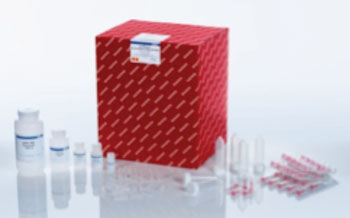Novel Spin Column-Based Kits for Standardized Extraction of Exosome RNA
By LabMedica International staff writers
Posted on 22 Sep 2015
A novel spin column-based method has been developed that provides a faster, more reliable means for the isolation of RNA from exosomes for research, delivering high-quality results with less labor-intensive sample preparation.Posted on 22 Sep 2015
Exosomes and other extracellular vesicles (commonly referred to as EVs) have generated considerable attention for their potential applications in both diagnostics and therapeutics. The contents of these vesicles are the subject of intense research, and the relatively recent discovery of RNA inside EVs has raised interest in the biological function of these RNAs as well as their potential as biomarkers for cancer and other diseases. Traditional ultracentrifugation-based protocols to isolate EVs are labor-intensive and subject to significant variability.

Image: exoRNeasy Serum/Plasma Kits for efficient purification of RNA from exosomes and other extracellular vesicles in serum or plasma samples (Photo courtesy of QIAGEN).
The traditional ultracentrifugation method for isolating EV RNA is now being superseded by a series of spin column-based extraction kits developed by QIAGEN (Venlo, The Netherlands) in conjunction with Exosome Diagnostics, Inc. (Cambridge, MA, USA) and marketed by QIAGEN under the name exoEasy (for whole EV isolation) and exoRNeasy (for extraction of EV RNA).
Use of the exoRNeasy kit was described in a paper in the August 28, 2015, online edition of the journal PLOS ONE that was authored by investigators from QIAGEN and Exosome Diagnostics. Briefly, pre-filtered plasma was mixed with binding buffer and added to the exoEasy membrane affinity column to bind the EVs to the membrane. After centrifugation, the flow-through was discarded, and wash buffer was added to the column to remove nonspecifically retained material. After another centrifugation and discarding of the flow-through, the vesicles were lysed by adding QIAzol to the spin column, and the lysate was collected by centrifugation. The miRNeasy Serum/Plasma Spike-In Control was added. Following addition of chloroform, thorough mixing, and centrifugation to separate organic and aqueous phases, the aqueous phase was recovered and mixed with ethanol. The sample-ethanol mixture was added to an RNeasy MinElute spin column and centrifuged. The column was washed three times with buffer followed by elution of RNA in water. This procedure allowed concentrating the extracellular RNA from four milliliters of plasma or serum into a final volume of 14 microliters of water. This method was an improvement over traditional methods in providing a faster, more standardized way to achieve reliable high quality RNA preparations from EVs in serum and plasma.
“The QIAGEN exoRNeasy Maxi Kit standardized protocol, developed in partnership with Exosome Diagnostics, Inc., is the most sophisticated method for the extraction of RNA from exosomes,” said contributing author Dr. Markus Sprenger-Haussels, head of the sample technologies unit at QIAGEN. “The study also reinforces QIAGEN’s leadership for sample technologies which are paving the way for the growing acceptance of liquid biopsies. QIAGEN provides a range of novel sample technologies for liquid biopsies to help gain valuable molecular insights from easily collected samples of blood or other liquids.”
“As the world leader in sample preparation, QIAGEN's partnership with Exosome Diagnostics is accelerating the pace at which researchers and drug developers across the globe are utilizing exosomes from biofluids. Exosomes provide a powerful molecular research approach that is getting significant attention given its many advantages over tissue-based approaches," said Dr. Johan Skog, CSO of Exosome Diagnostics. “Our ongoing collaboration with QIAGEN and these important new data provide further validation that Exosome Diagnostics' technology offers a highly sensitive and reproducible method to isolate and extract nucleic acid from exosomes for routine laboratory use.”
Related Links:
QIAGEN
Exosome Diagnostics, Inc.













